
In 2019, the number of deaths between the ages of zero and five worldwide, dropped to the lowest point ever recorded in history (5.2 million, down nearly 60 percent from 12.5 million in 1990).
This was reported in the document Levels and Trends in Child Mortality 2020, produced by Unicef, the World Health Organization, the United Nations Population Division, and the World Bank.
According to the report's data, even before the Coronavirus pandemic, newborns were at the highest risk of mortality.
In 2019, a newborn child would die every 13 seconds, about 6,700 per day. The incidence of newborn mortality (0-1 month) within overall infant mortality (0-5 years) has risen from 40 percent in 1990 to 47 percent today.
Analyses conducted by Unicef and the World Health Organization highlight the severe limitations and disruptions to national health services caused by the pandemic, which threaten to put an end to decades of hard-won progress.
Over the past 30 years, interventions to prevent or treat the causes of child mortality (from premature births to underweight births, from birth complications to neonatal sepsis, from pneumonia to diarrhea and malaria), coupled with the expansion of immunization, have saved millions of lives.
Today, worldwide maternal and child health services have suffered disruptions due to a shortage of economic and human resources (absorbed by the fight against Covid-19) and a general unease in the use of health services due to the fear of contracting the coronavirus.

